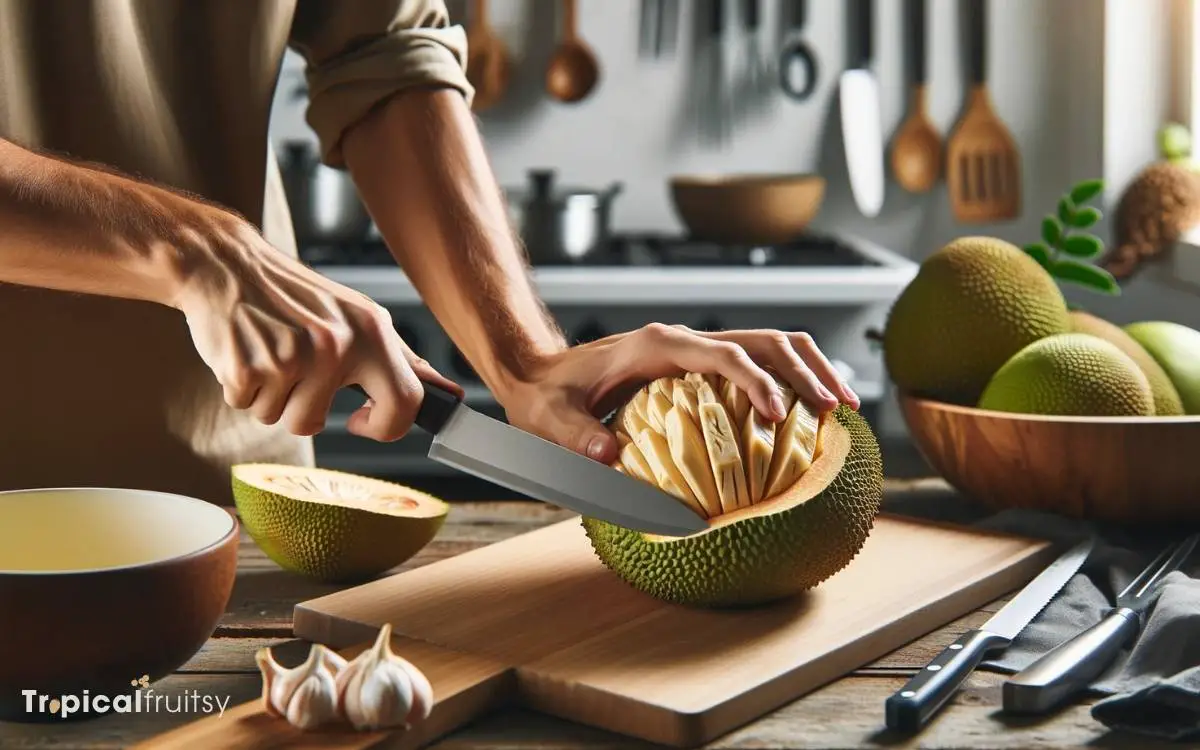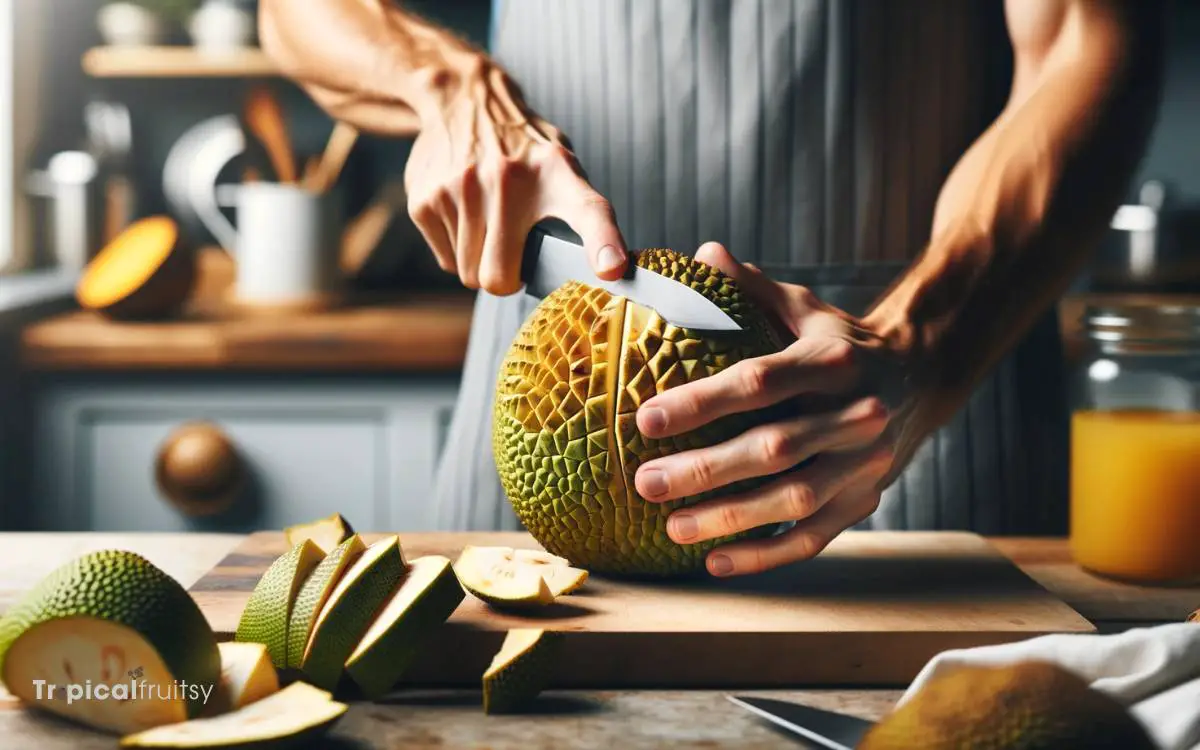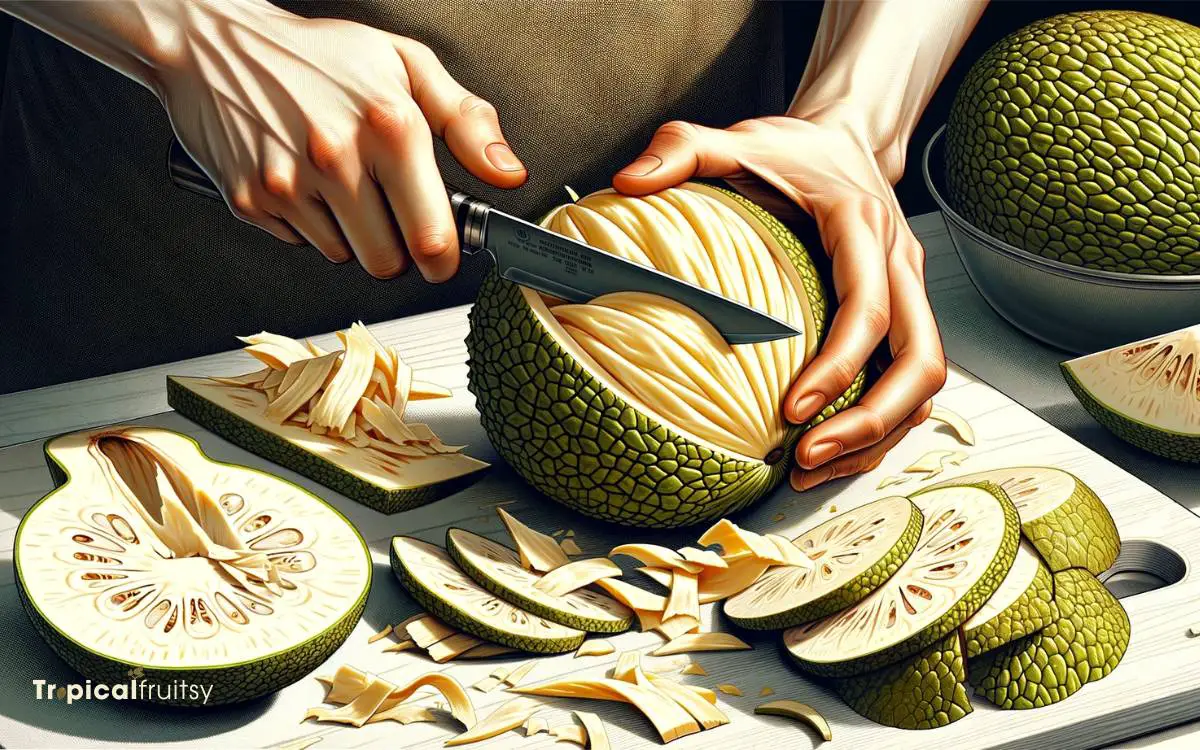How to Peel a Breadfruit? 4 Easy Step!
To peel a breadfruit effectively, you need a sharp knife and a sturdy surface. Start by cutting off the stem and base of the fruit to create a flat surface.
Make incisions in the skin, then use the knife to lift and peel away the thick outer layer. Once peeled, the breadfruit is ready to be cooked in various culinary applications.
The process of peeling a breadfruit involves:
Master the art of peeling breadfruit to unlock a world of tropical flavors and textures in your cooking.

Key Takeaway
Gather Your Tools
Before commencing the peeling process, assemble the necessary tools including a sharp knife, a cutting board, and a bowl of water.
The knife must be honed to a keen edge to ensure a clean cut through the breadfruit’s thick skin without excessive force, which could compromise the integrity of the flesh.
The cutting board should be stable and made of a material that resists cuts, providing a secure base for slicing.
A bowl of water is essential for rinsing the knife, as sap from the breadfruit can be sticky and may interfere with the peeling process. With these tools prepared, you are positioned to execute the task with efficiency and precision.
Having the right equipment at hand, the next critical step is selecting the perfect breadfruit for peeling.
Step 1: Selecting the Perfect Breadfruit

Identify a ripe breadfruit by its slightly soft texture and sweet, fragrant aroma, ensuring it is at the ideal stage for peeling and consumption. Selecting the optimal breadfruit is paramount for both culinary success and nutritional benefit.
Here are key indicators to guide your selection:
- Surface Appearance: Look for a green to yellow-green skin color, with brown patches that signal ripeness, avoiding any with excessive blemishes or signs of decay.
- Firmness: Gently press the surface. A perfect breadfruit should give slightly under pressure, indicating a creamy and starchy interior, ideal for cooking.
- Stem Health: The stem should be intact and show no signs of mold or excessive dryness, as this can reflect the freshness and overall quality of the fruit.
Step 2: Cutting Technique Basics

Once you have selected a ripe breadfruit, employing the proper cutting technique is crucial to efficiently peel and prepare it for cooking.
Begin by washing the breadfruit thoroughly to remove any surface dirt or residue. Place the fruit on a stable cutting board to prevent slippage.
Using a sharp knife with a sufficient blade length is imperative; a dull knife may slip and cause injury, or crush the fruit rather than slice cleanly through it. Make an incision at the stem and base to remove these parts.
Then, score the skin into quarters, cutting just deep enough to penetrate the rind without damaging the flesh.
The cuts should facilitate the removal of the skin in large sections, minimizing waste while preserving the maximum amount of fruit.
Step 3: Removing the Skin

After scoring the skin into quarters, gently pry the edges of each section away from the flesh and peel it back, using a downward motion to remove the skin efficiently without pulling away the edible fruit.
This process requires meticulous care to ensure the flesh remains intact, maximizing the yield of the breadfruit.
Here are some key steps to follow:
- Use a sharp knife to score the skin deeply enough that it penetrates the outer layer without slicing into the fruit’s flesh.
- Work your fingers or a blunt instrument like a spoon’s edge under the scored skin to carefully lift it away from the fruit.
- Peel each section of skin off in a smooth, continuous motion, adjusting the angle of peeling to minimize waste.
Maintaining a steady hand and a patient approach are crucial for removing the skin without compromising the quality of the breadfruit.
Can I Use the Breadfruit I Grow to Peel and Eat?
Yes, you can use the breadfruit you are growing from cutting to peel and eat. Breadfruit can be consumed at different stages of ripeness, so you can pick it when it’s mature and it will be perfect to peel and eat.
Step 4: Post-Peeling Tips

Upon successfully peeling the breadfruit, it is imperative to employ proper handling techniques to preserve the fruit’s quality and prepare it for cooking or consumption.
The flesh of breadfruit is highly susceptible to oxidation, which can compromise its flavor and nutritional value.
Immediate cooking is recommended; however, if there is a need to store the peeled fruit, certain measures should be taken.
| Storage Method | Duration | Tips |
|---|---|---|
| Cold Water | Short-term | Submerge in water with lemon juice |
| Refrigeration | 1-2 Days | Place in an airtight container |
| Freezing | Up to 6 Months | Blanch before freezing |
| Vacuum Sealing | Varies | Ideal for long-term storage |
| Cooking | Immediate | Prevents oxidation and preserves taste |
Select a method that aligns with your timing and intended use to ensure the breadfruit remains as fresh and palatable as possible.
Conclusion
In the culinary odyssey of tropical gastronomy, the peeling of a breadfruit stands as a rite of passage, unveiling the starchy treasure within.
Masters of this ancient craft recognize that, with the proper tools and technique, the armored facade of this exotic sustenance gives way to a canvas of culinary potential.
Thus, the art of breadfruit peeling is not merely a preparatory step but a transformative ritual that metamorphoses the unyielding into the delectable.






